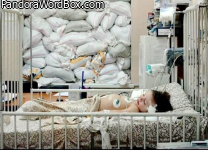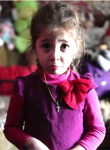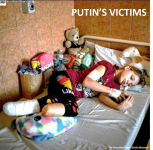|
× UKRAINIAN CHILDREN WITH DISABILITIES HAVE SPECIAL NEEDS |
MEDICAL TERMINOLOGY NOMENCLATURE VOCABULARY GLOSSARY
ROOTS ETYMOLOGY IDEONOMY
Grasping Ideas in Words - Natural Learning and Remembering
NOTICE! (CAVIAT) - use General Search Box to find non-medical terms
~ -; DASH is a signal indicative of a delimiter related to a prefix or suffix
~ A-; prefix often denoting “lack of x, y, or z” (see atrichia)
BONUS - a-trichia implies lack of, see hair or see alopecia given below
~ A ...; as a prefix it often denotes “lack of x, y, or z” (see atrichia)
~ Abd …; prefix for away as in abduction
BONUS - to remember; abd and related - take away, kidnap, rape ...
BONUS - to remember; more about abd - abductions, ...
~ Abducent; e.g. motor
nerves or muscles producing motion away from the anatomical
axis or at times
referred to as “exterior” motion
~ Abduct; abduction, to move away, kidnap, abduction implies rape, in Spanish rapto is
abduct and in Ukrainian implies suddenly (raptovo)
BONUS - see abduction
BONUS - see abducted (open) thighs - oppossite of adducted
~ Abdomen; ventral refers
to “vientre” from vento or wind and in medicine to structures
anterior to the
body axis, poetically known as “bag of winds”, container of “abducted”
nutrients and organs, “ventrally from” implies “in front of”
BONUS - see nephrosis, ascitis
BONUS - see hepatitis, ascitis
BONUS - see hypotonia
~ Achondroplasia;
~ Acomia;
~ Acro~; prefix denoting distal as in acro-megaly, etc.
BONUS - to remember; acro, meso, ecto, ...
~ Acrocyanosis;
acro=distant, cyanosis=blue like the sky (cielo in Spanish)
~ Acrodysplasia; abnormalities of
distal structures
~ Acromegaly; enlarged distal structures
~ Adipose; fatty, aleipha in Greek, olyj or oil in Ukr
BONUS - see adiposity
~ Agenesis; (a-genesis), lack of gene(s) resulting in lack of development of particular
cells, tissues, organs (implies material and not functional consequences)
~ Alae nasi; lateral areas (wings) or nostrils
~ Alcohol; fluid
product from natural fermentation of sugars, mainly see ethanol
~ Alcoholism; *see
addiction, implies dependence and negative impacts, *see teratogen.
~ Allele; alternative form of a gene
~ Alopecia; lack of hair, opposite of hirsutism
BONUS - a-trichia implies lack of, see hair or see alopecia given below
~ Amblyopia; [often used as a synonym of strabismus, the symptom of which often
is double vision - ambliopia, diplopia]. Vulgar and mistaken medical parlance, equate
this term with “lazy eye”, “dim vision”. See strabismus.
~ Amelia; absence of a limb or limbs
~ Amnesia;
~ Amputation;
~ Analgesic; factor or agent that diminishes or prevents pain; see morphine
~ Anamnesis; remembrance or recall of symptoms, signs and
circumstances
~ Andro~; prefix indicative of maleness, as shown next
~ Androgen; agents that masculinize
~ Aneurysm; segmental dilatation of an artery, vein or other tubular
structures due to
flaws of its walls
~ Angioma; vascular tumor (general term - see hemangioma etc.- see
ectasia)
~ Ankylo-; prefix denoting “crooked”, bent, curved, deviated, fused, stiff, fixed, ...
BONUS - perspective includes ankle articulation or joint
~ Anophthalmia; see microphthalmia
~ Anotia; "no" ear or auricle
~ Antenna; detector of signals generally invisible and generally by
touch
~ Antepartum; before birth or parturition implying materno-fetal partition
~ Antihelix; anti=against the helix, implying near; ante=in front of
BONUS - see ear landmarks
BONUS - see protruding ears of an Emperor
~ Antitragus; similar to antihelix, tragus in Greek points to he-goat, as in tragedy
BONUS - see ear landmarks
BONUS - see protruding ears of an Emperor
~ Apathetic, apathy; lacking “pathos” or emotion, sign of mental depression, see apathy
~ Apathy; lacking (see) “pathos” or spirit (emotion)
~ Aplasia; (a-plasia), “no” or lack of development (cells, tissues, organs), excludes notion
of functions, does NOT imply lack of capacity to develop (genes, denoted by agenesis),
see agenesis
~ Arm; upper limb, body part that holds weapons (armament)
~ Arthro; arthron implies articulation or joint, as in arthropod,
arthritis, …
~ Arthrogryposis; implies multiple congenital joint contractures in
diverse body parts
~ Ascitis; abdomen with fluid, from ascos (Greek for wineskin implying "stink"), in Spanish
asco means repugnant or odious odor
BONUS - see nephrosis, ascitis
BONUS - see hepatitis, ascitis
~ Asymmetry; lacking expected likeness
~ Atom;
~ Atrichia; lack of hair or alopecia - note hirsute for excess of hair
BONUS - a-trichia implies lack of, see hair or see alopecia given below
~ Atrophy;
~ Audio; sound as in audible, audience ...
~ Auricle; external
ear, ear lobe
~ Autosomal; loci or genes located on autosomal chromosomes thus not on the sex
chromosomes X nor Y
~ Birth defect; flawed political popular term for congenital
anomaly
~ Blastopathy;
abnormalities of the blastula (see blastula)
~ Blastula; early development of a fertilized egg when the morula (solid
sphere of cells)
develops a cavity (blast), from Greek “blastos” for “sprout” - perhaps relatged, blast
as implied by "explosion", the growth of the morula-blastula becomes very frast as
if an "explosion" of cell divisions
~ Bone; hard tissue implying calcified
~ Cafe au lait; reference to skin maculas of the "coffee with milk" tint
~ Cancer;
uncontrolled division of abnormal cells spreading in a pattern suggestive of
the legs of a crab from Greek “kakinos” or Latin “cancer”
~ Carpe diem; find (search) via General Search Box
~ Casuistics; cumulative experience from exposure to “cases” (ww, Ed.)
~ Cataract;
~ Caudad; pertaining to the tail of "end"
~ Caviat; be aware, to note
~ Cele; or coele, in Medicine implies cavity, hernia, swelling
~ Cephal; prefix - cepha-lad, superior or opposite to caudad (see cauda); cephal-ic
denotes pertaining to the anterior or top areas of an animal or cephalon
~ Cleft; gap (congenital, implying agenesis or aplasia), acquired (failed healing or
artificially induced), strictly speaking SCHITSIS as in schizophrenia (split or cleft mind)
BONUS - see vast perspective of this notion
~ Clinic;
~ Clinical;
~ Clone; implies identicity; in Medicine, group of cells identical to their ancestor,
when applied to whole organisms, the implication is non-sexual reproduction
~ Cocaine;
~ Codeine; derivative of (see morphine) - mainly prescribed to treat moderate or severe
pain (see analgesic) - highly addictive (see narcotic) - the implicit notions are very
complex and outlined in entries shown in parentheses, plus note bonus link below
BONUS - ALK ALKALEMIA ALKALI ALKALOIDS - Morphine, Codeine, Quinine, Atropine,
Strychnine, ...
~ Codone;
~ Cognizant;
~ Collagen; extracellular "glue" protein, see colloid
~ Colloid; a gel like substance, in vernacular "glue-like" or gelatin or jelly - note - in
Spanish, "cola" means tail as well as glue - animal tails are rich in collagen -
human collagen disorders are many and cause fragility of the tissues the collagen
sustains in place - a cadaver as it cools, the collagen stiffens - a "stiff" in jargon
denotes a dead person
~ Coloboma; gap (like a cut) generally of ocular structures often irides
~ Coma;
~ Congenital;
~ Consanguinity;
~ Cranium; skull, skeletal or bone component of the head or cephalon
~ Crease; folding or groove
~ Credo; belief
~ Cretinism;
~ Cross-bread; preferred term for intra-cohort breading instead of
in-breading
~ Cutis; skin
~ Cutis marmorata; pink marble like skin implying mottled skin
~ Cupid; mythological emblem mainly denoting temptation driving desire
~ Cupid bow; outline of
the vermillion of the upper lip in a shape of an arch, Cupid shot
love arrows
and humans blow kisses from the upper lip
~ Cupid bow flat or not evident;
the sign observed among instances of fetal alcohol
effects, syndrome, or
spectrum disorders
~ Cure;
~ Cyclopia; fused eyes (not a failure of "splitting")
~ Cyst;
~ Dactyly;
~ Day-dreaming;
~ Death;
~ Decline;
~ Deformation; external causes of anomalies, dys-morphism
~ Delirium;
~ De novo;
~ Dia;
~ Diabetes;
~ Diagnosis; hypothetical label - synthesis of (objective) signs/natural
history with
(hypothetical) pathogenesis/etiology
~ Dialysis;
~ Diaphoresis;
~ Digit;
~ Diplopia;
~ Disease; mental or physical instability, away from homeostasis
~ Dis; “rupture” of a process, see more in dys
~ Disorder; characteristic of malformations and diseases
~ Disproportion;
~ Disruption; implies external negative impact
~ Dominant; implies pathology due to the presence of one thus single
mutated
pathogenic allele
~ Dormant;
~ Dorsal; often used to denote "supra" (during embryogenesis
the occiput may be
included in dorsal)
~ Down syndrome; concurrent symptoms and clinical signs suggestive of an extra
chromosome 21 or its segments (trisomy 21)
~ Dys~; or dis, prefix for diseased or "anomaly" or ab-normal, note also “dis”
~ Dysmorphism;
~ Dysmorphogenesis;
~ Dysmorphology;
study of altered morphology (implicitly disproportions or anomalies,
deformities, malformities, ...
BONUS - see further perspectives
~ Dysplasia; altered
tissue formation - normal cells but disorganized - e.g. hamartoma,
polyp,
nevus, neurofibroma
~ Dyssomnia;
~ Ear; or auricle,
also inner, middle and outer or external ears form the auditory system
~ Ecology;
~ Ectasia; implies distension - dilatation related to altered
"flow" in a tubular structure in
contrast to aneurysm due to flaws in
walls
~ Ectoderm; ecto implies external
~ Ectro-;
~ Edema; from “oid” for “to swell” in Greek
~ Emaciate; “macer”
in Latin for thin, lost flesh as per "macerate"
~ Embryo; an organism
during early development and giving rise to a fetus
~ Embryology;
~ Embryopathy;
anomalies of the embryo
~ Endemic;
~ Endocrine;
~ Environment;
~ Epi~; prefix for above as in epi-demiology (pertaining to people)
~ Epicanthus; Epicanthic fold; epi - canthus
- skin fold above the (ocular inner) angle
~ Epidemic;
~ Epidemiology;
~ Epidermis; skin (above the "flesh")
~ Epigenetic;
~ Eso; Greek for "inward" as in esotropia
~ Esotropia; inward or convergent strabismus or squint
~ Ethanol; eth and ol
denote a chain of two carbons one of which is linked to OH ethyl
group (EtOH)
expressed by the chemical formula CH3-CH2-OH;
a liquid flammable
addictive human psychotoxin (an inhibitor of inhibitions),
see alcoholism
~ Ethics; see "ethos", in essence, the “thuth”
~ Ethnic;
~ Ethnos; strictly speaking it denotes a distinct people and points
towards ethos and
ethics
~ Ethos (soul), ethnic; natural of a group
~ Etiology; true cause, see Etios
~ Etios; Greek for spirit pointing to "true"
~ Etymology; the true origin, mainly of words
~ Euthanasia;
~ Exo; Greek for "out" as in exotic, exotropia
~ Ex-omphalon;
~ Exotropia; outward or divergent strabismus
~ Face, facade;
front, communication organ/devise
~ Facies; a face that
“speaks”, conveys a meaning
~ FAE; fetal alcohol effect, see FAS and FASD
~ FAS; fetal alcohol syndrome, implies full array of concurrent signs,
see FASD
~ FASD; fetal alcohol spectrum disorder, implies incomplete array of FAS
signs
~ Facoma; see phacomatosis
~ Facomatosis; see phacomatosis
~ Fantasy;
~ Febricula; often implies low-grade recurrent episode of (see) fever; late-day rise of
levels of temperature are characteristic of some stages of tuberculosis (TBC)
~ Fertile; capable of reproduction, fruitful, fecund
~ Fever; a syndrome of hyperthermia with concurrent "febrile" symptoms and signs, often
sophistically characteristic to suggest etiology (cause), such as childhood exanthemas
(measles, rubella, etc.)
~ Fistula; a tubular hallow abnormal canal or tunnel-like between organs
or the exterior
~ Flaccid;
~ Foca; see phoca
~ Fontanelle;
~ Frenzy;
~ FTT, failure to thrive, implies delay of mental, physical, growth and
maturation
~ Gen-;
~ Gender; psychological (personality, behaviour, sexual drived, libido) characteristic of
biologic males in contrast to biologic females, see more under "sex"
~ Gene, genius, generator; messenger
~ Genetics; the study of inherited and or hereditary organisms or their
components
~ Genome; the totality of genes of an organism
~ Gigantism;
~ Gloss-;
~ Glossa; tongue, language
~ Glossectomy;
~ Glycemia;
~ Goiter;
~ Gonad;
~ Gyneco-mastia; developed female breast in a male
~ Hallucination;
~ Hamartoma; circumscribed areas of dysplastic tissues (facomas or
phacomas) prone to
uncontrolled growth and malignant changes
~ Hamartomatosis; systemic multiple, generally congenital, benign neoplasia, often pre-
malignant, e.g. multiple neurofibromatosis
~ Hamartosis; see Hamartomatosis
~ Health; optimal
homeostasis of an organism at a particular stage of development and
lifespan
(includes a mental optimal state)
~ Helix;
~ Hemangiona; vascular tumor (general term akin to angioma, see ectasia)
~ Hemi-;
~ Hermaphroditism; strictly speaking, there is no human hermaphroditism. The term
implies the capacity of self-replication (it negates sexual reproduction). However,
medical literature uses this term to describe, in most instances, ovo-testes or "mixed
gonadal dysgenesis" (a high cancer risk anomalies thus an indication for surgical
removal of such gonads). Pseudo-hermaphroditism, male variety (feminized males)
and female variety (masculinized females). Personally, I find such "labels" offensive,
degrading, arrogant, dogmatic and socially damaging. Personally, since the causes
and pathogenesis of such disorders are multiple and complex, an acceptable alternative
may be to describe actual clinical features as kindly as possible; gynecomastia for
example does not have to be branded as an instance of "feminized male" or a large
clitoris be branded as in instance of a pseudohermaphroditism or equally offensive
branding as an instance of a "masculinized female". (more in an Overview on this
subject)
~ Heroin;
~ Hirsutism; excess
of hair - note atrichia for lack of hair or alopecia
~ Holo~; prefix for totality, whole, wholly
~ Holoprosencephaly; a forebrain undivided into left and right
hemispheres
~ Homeostasis;
health, stability
~ Hydramnios;
~ Hydrocephalus;
~ Hyper; prefix for excess, see hyper-x,y,z
~ Hyperplasia; enlargement on the basis of more numerous cells
~ Hypertelorism;
increased inter-ocular distance, see telorism
~ Hyperthermia; elevated temperature; hyperthermia is not a synonym of fever which is a
syndrome (see specific entry); hyperthermia, if localized, is a reflection of increased
blood flow associated with an underlying vascular anomaly, an inflammatory process,
or a neoplasia. Generalized body hyperthermia can be induced by exercise or external
factors such as sources of energy (sun and other forms of radiation), hot bath, etc.
Hyperthermia is a teratogen - a known cause of oral and limb malformations among
other anomalies.
~ Hypertrichosis;
hirsutism or excess of hair, see trichosis
~ Hypertrophy; enlargement including of cells
~ Hypnos;
~ Hypnotic;
~ Hypo;
~ Hypotelorism; decreased inter-ocular distance, see telorism
~ Hypothesis;
~ Hypotonia;
~ Hypotrichosis; sparse hair, see trichosis, alopecia
~ Illusion;
~ Implication; plica (fold), “folded in”
~ Imprinting;
~ IMV; informative morphogenic variant
~ Incest;
~ Iniencephaly; a neural tube defects mostly impacting the neck (inion), atlas and axis cervical vertebrae. Concurrent encephaloceles and schises of the neural cord are
common as well as other malformations. The cardinal sign is a severe retroflexion of
the neck
~ Inion; root for neck, iniencephaly
~ Insomnia;
~ Ion;
~ Ionizing; energy capable of converting atoms and molecules into ions
~ Iridoschisis, see Coloboma
~ IUGR; intrauterine growth retardation;
~ Lethal;
~ Lethargy;
~ Leukemia; strictly it denotes “white blood”, in Medicine an abnormal
malignant
excessive proliferation of “white blood cells” (leukocytes)
~ Life; individual organism capable of capturing energy for its perpetuation
~ Limb; extensions of body stalk, populist term "extremities", see Limbus
BONUS - to remember - limb, limbic, limbus, ...
~ Limber; hypotonia, flexible, agile, pliable, nimble, elastic
BONUS - to remember - limb, limbic, limbus, ...
~ Limbic; refers to the thalamus and hypothalamus, see Limbus
BONUS - to remember - limb, limbic, limbus, ...
~ Limbo; oblivion, nowhere, limit or area between paradise and hell according to the
Vatican
BONUS - to remember - limb, limbic, limbus, ...
~ Limbus; limit, edge, border …
BONUS - to remember - limb, limbic, limbus, ...
~ Lingua-;
~ Lingula;
~ Lipid; a wax, fat, sterol, vitamin, glyceride
~ Locus; position on a chromosome
~ Lobe; a part of a generally flat and round structure
~ Lobule; a small lobe
~ Lysosome;
~ Macro; big, large as in macro-x,y,z
~ Macrocephaly; large head or macrocrania or megalocephaly
~ Macroglossia;
~ Macrognathia; generally referred to as prognatism
~ Macrosomia;
~ Macula; skin blemish
~ Malar; cheek bone or zygoma, see zygote
~ Male; in humans the sex (sector of population) capable of producing sperm.
Consider a poetic potential link with muscle.
~ Malformation; a failure of morphogenesis (studied by Dysmorphology)
~ Malrotation;
~ Mathematics;
~ Maxillar; vernacular for jaw, cheek bone or malar from Latin
"mala"
~ Megalo...; prefix for enlarged as in megalomania
~ Megalocephaly;
~ Melanoma; neoplasia of melanic cells (melanocytes), mostly in the skin
~ Melia; root denoting limb (also melic) as in mesomelia or meromelia
~ Melic; root ( also melia) enoting limb as in rhizomelic dwarfism
~ Mero; prefix, generally meaning implying minimal or merely, see meromelia
~ Meromelia; partial absence of a limb (congenital "amputations")
~ Meso; prefix for middle or central, see mesomelia
~ Mesomelia; middle or central parts of a limb, see melia
~ Metabolism;
~ Micro; small as in micro-x,y,z
~ Microcephaly;
reduced head size by 2 or more standard deviations
~ Micrognathia;
reduced size mandible or chin
~ Microphthalmia -
implies existence of an under-developed and immature ocular globe
~ Microtia;
~ Monozygotic; origin from one single zygote
~ Morphine;
~ Morphogenesis;
~ Morphology; shape, proportions
~ Mucopolysaccharide;
~ Mucopolysaccharidoses (MPS);
~ Muscle; contractile tissue. Note poetry in muscle - masculine - muzh (in Ukrainian
males) - mus emerges from mouse and the notion that muscle bundles, when
contracting, raise the skin, as if little mice were running under - in Ukrainian "myshi"
means "mice".
~ Mutagen; agent that alters genetic codes, heritable or not
~ Mutation;
~ Narcissism;
~ Narcolepsy;
~ Narcotic; any agent that alters the mental status - probably the political force of
the alcohol beverages corporations, an additional point was added - "consumed
illegally" (the intent reflects a process that shields corpporations selling alcoholic
spirits from being branded as narcotic merchants). Under this corrupting political
influence, oxycodeine, a synthetic opioid that causes thousands of death yearly, is
not a narcotic.
~ Natural history;
~ Nature; all living, see life
~ Navel; see umbilicus, a ship is tied to the shore, the baby (ship) is
tied to the placenta
(attached to the mother)
~ Neuroblast; blast implies source of cells
~ Neoplasia; new tissue, by implication abnormal or distinct from the
original
~ Neurofibromatosis; a systemic multi-tissue defect due to a single
autosomal gene
mutation
~ Night;
~ Nightmare;
~ Noctambulist;
~ Nomenclature; clue
given by a name
~ Norm; feature observed in the majority (95%) of subjects
~ Normal, norm; prevalent, optimal
~ Nosocomial; acquired in a hospital
~ Nosology; categorization of ailments akin but not identical to natural history
~ Nostalgia; remembrances with yearning, longing, a sense of loss
~ Nostology; mental deterioration resulting from senility
~ Nostril; nares, nasal external opening
~ Novocaine;
~ Noxa;
~ Noxious;
~ Nutrient;
~ Obesity;
~ Obsession; unwanted intrusive compelling persistent recurring ideas
and feelings
may be a
prodrome of zeal, mania, madness
~ Order; best fit, health
~ Omphal-;
~ Omphalocele; herniated omphalon or navel, umbilical or central abdominal area
~ Omphalon; implies "central"
~ Oncogene; gene increasing carcinogenesis risk
~ Opioid;
~ Organ; implies multiple tissues "organized" functionally, implies interactions
~ Orgasm; seizure or climax from stimulation of erotic zones perceived as pleasure
~ Otic; pertaining to the auditory system, meaning can be linited to "ear"
~ Overdosis;
~ Oxycodone;
~ Palpebral fissure; implies “eye opening size” Parlance; professional jargon
~ Paralysis;
~ Paternity;
~ Pathos; implies
development of a "sense" or "feeling"
~ Pathogenesis; in Medicine, mechanism generating an anomaly
~ Pathology;
~ Pectus; shield, sternum, see pectus-carinatum/excavatum
~ Pectus carinatum; keel, ridged sternum
~ Pectus excavatum: cavity, trench, sunken sternum
~ Penetrance; proportion of individuals expressing an inherited
gene
~ Phacomatosis; mostly neuro-cutaneous and/or vascular reflecting
neoplastic growth of
hamartomatous tissues (see hamartoma)
~ Philtrum; concavity
(fossa) under the nose
~ Phobia;
~ Phobos;
~ Phoca; or phoca, in Greek and Latin - seal or foca in Spanish, see phocomelia
~ Phocomelia; foca (seal), melia (limbs), implies underdevelopment of all 4 limbs
~ Phrenia; mind, as in oligophrenia
~ Phrenology; study of the mind
~ Physiognomy; study
of facial signals
~ Piggery; enterprise of breading swine (often a resource for Teratology
investigations
~ Placenta; a flat, round, and brittle fetal organ (resembling a
cheesecake) attached to
the uterus and connected per an umbilical cord to a
fetus surrounded by membrane
~ Plas-;
~ Plastos; element in dysplasia, metaplasia, aplasia, ... in Greek -
implies "molding" as in
"shaping" thus proportions,
organization ...
~ Pleotropism; plethora (multiplicity) of signs caused by a gene
mutation
~ Polymath; highly-knowledgeable person; learned individual in a large number of
disciplines
~ Prevalence;
~ Primacy; most important
~ Proboscis; tube like nose or snout
~ Prognathism; prominent jaw or macrognathia
~ Prolabium; central
part of the upper lip
~ Psyche;
~ Psychology;
~ Ptosis;
fallen
~ Race;
~ Radiation; energy emitted in waves of subatomic particles
~ Recessive: implies impacts of both alleles (see alternative in
"dominant");
~ Regeneration; restoration of destroyed cells with minimal or no flaws
~ Rhino; root for
words referring to nose
~ Rhizo; prefix for proxima or root of
~ Rhizomelia; abnormality of the proximal or root of limbs (melia)
~ Rudiment; preferred term to underdeveloped, etc.
~ Schisis; cut, separation, division, gap, see cleft
BONUS - see vast perspective of this notion
~ Schizophrenia; double or split mind (reality - visions - delirium)
BONUS - see vast perspective of this notion
~ Sedative;
~ Semiology;
~ Sex; currently implies physical and not mental male vs female dichotomies of attributes
indicative of contrasts characteristic of 46,XX compared to 46,XY chromosomal
complements
~ Sialorrhea;
~ Sign; objective
evidence of an event
~ Signal;
significance or interpretation of a sign
~ Simian crease; single transverse palmar flexion crease
~ Sinciput; see next
~ Sinciputal; in brief, anterior area of the forehead (site of frontal
encephaloceles)
~ Skull; cranium, head, cephalon implies vertex or top
~ Sleep; as if "slip away"; cyclic relative inactivity of cerebral and other components of
the nervous system expressed mainly as consciousness and muscle tone. During sleep
there is a shift away from a daylight mode to a night mode from the homeostasis
regulated by the autonomic-endocrine systems. Shifts include urinary excretion and
body temperature, among other parameters.
~ Soma;
~ Somnambulism;
~ Somnolence;
~ Somnulent;
~ Somnus;
~ Soporific;
~ Spina bifida;
~ Sporadic;
~ Squint; strabismus
- in medical parlance deviated eye/eyes
~ Sterile; infertile
~ Stigma; a signal or mark generally negative
~ Stocada - in Spanish a thrust of a sword from "estoque" (during duels the site where a sword may wound an opponent was relatively random).
~ Stochastics - "learned guess", from stokhos in Greek for "guess"; informally implying "random"; a statistical notion of a better definition of randomness in a particular scale, a process based on probability theory analysis of random variables in a defined probability space inclusive of time and sequence. Often a basis of mathematical models of random events.
~ Strabismus; or
heterotopia. In essence, it indicates that the axis of the ocular globes
are not parleo or cannot converge (focus) on an object. In vernacular referred to as
squint or deviated eye or eyes, see esotropia etc.
BONUS - to remember; adult oneset - occular nerve palsy (paralysis)
~ Stress;
~ Stupid;
~ Stupor;
~ Suicide;
~ Sydney crease; proximal palmar flexion crease reaching the ulnar
border
~ Symmetry;
~ Symptom; perceived
sensations by an individual capable of describing and transmitting
them for a
physician to interpret to what extend symptoms qualify as a sign (see sign)
~ Syn; root for
together, joined, confluent as in symphony
~ Syndrome; concurrent
characteristic consistent symptoms and signs
~ Synophris; convergent eyebrows
~ Telorism; distance
between paired structures, see hyper-telorism
~ Teratogen; any
environmental cause of developmental anomalies
~ Teratology;
discipline concerned with teratogens (see above)
BONUS - see further perspectives
BONUS - laws and principles
~ Teratoma; a tumor
composed of cells derived from each of the three embryonal
layers (ectoderm,
endoderm, and mesoderm), implies and independently growing
a disorganized mass
of cells that may be malignant in nature
~ Teratos;
~ Teratothanasia; embryonal or fetal death due to fatal defects
~ Thanatophoric;
~ Thelarche; onset of postnatal
breast (mammary) development usually at puberty (in
Greek thele is nipple)
~ Therapist;
~ Therapy;
~ Therm-;
~ Thermia;
~ Thyroid;
~ Tone;
~ Tongue; germanic word, in Medicine note GLOSSA and LINGUA incorporated into
terms like MACROGLOSSIA or LINGUAL; tongue denotes a fleshy muscular oral organ
(implying composed of a variety of tissues) necessary for tasting, licking, sucking,
swallowing, and articulation of speech.
~ Torticollis; implies torsion or twisted neck, related to tort, contort, torture, etc.
~ Torsion; see torture
~ Torture; methods to produce pain inducing contortions
~ Toxin; poison, a
cause of death or illness, from organic or inorganic source, implies
impacts
from miniscule or modest doses (virtually all substances at high doses are
toxic,
including oxygen)
~ Tragus;
~ Trichosis; pertaining hair, see hypo-hyper, alopecia
~ Trisomy; three bodies, here denotes a chromosome in triplicate
~ Troph-;
~ Tuberous sclerosis;
~ Tumor;
~ Tumorogenesis;
~ Twin dizygotic; two individuals gestated concurrently from two
fertilized eggs
~ Twin monozygotic; one of two individuals from the same fertilized egg
~ Umbilicus; or navel, the center of an individual, in humans the
attachment site of the
placental cord, see navel
~ Usual; among the most frequent, customary, implies “normal”
~ Variant; "different", rare but within the 95% considered as
"normal"
~ Venal; prone to be corrupted, linked to venal, venereal, Venus
~ Venereal; pertaining to genesis, genitals, gene, points toward Venus, implies desire,
reproductive organs, etc.
~ Vermillion; red color, in medicine visible mucosa of lips
~ Vermin;
~ Volar (skin); ridged skin (dermatoglyphic ridges), *see cutis, not implication in “volar” or
“to fly in Spanish” – primates who “fly” between trees have areas of prehensible areas
of the skin that are ridged (hands, feet, tails) – the study of patterns of ridged volar
areas is the concern of the science of Dermatoglyphics
~ X-linked; implies loci on the X chromosome
~ Y-linked; implies loci on the Y chromosome
~ Zygote, zygoma: yoked, sperm-egg conjugated








